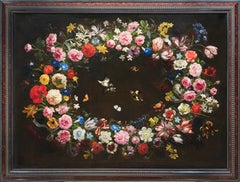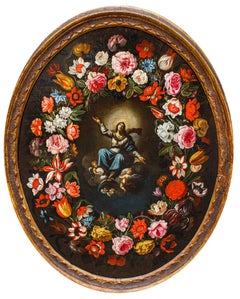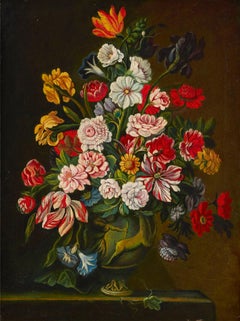Giovanni Stanchi Art
Italian, 1608-1675
Giovanni Stanchi, known as Dei Fiori (Rome, about 1608 - 1675), was an Italian painter.
Author of still lifes, his flower paintings are remarkable. He is present in many art catalogs and antiques auctions. A painting of him (Garland of flowers and butterflies) is exhibited at the Uffizi Gallery in Florence.
We still know little about Giovanni Stanchi and about the rest of his prolific family of naturamortists, who worked in Rome for almost the entire seventeenth century, and even less do we know how their workshop and their collaborations were organized (very close at least since the fifth decade of the seventeenth century, not only in the largest and most demanding canvases), so much so that some scholars prefer not to venture into the distinction of individual hands.
In any case, it is likely that Giovanni, born several years before the brothers Niccolò and Angelo, is one of the artists who marked the transition from Caravaggesque naturalism to the more mature phase of Baroque decorativism. Indeed, it is possible that he - together with Michelangelo Cerquozzi, with whom he has many affinities - was trained in the workshop of Agostino Verrocchio, perhaps the most important in Rome in the third / fourth decade of the seventeenth century and the last custodian of naturalism at the beginning of the century, as he hypothesized the art historian Alberto Cottino.(Biography provided by Antichita Castelbarco)
to
2
2
2
Flower Garland by Giovanni Stanchi, the most Flemish Italian flower painter
By Giovanni Stanchi
Located in PARIS, FR
This painting is reproduced in the reference book on Roman still life "Pittori di nature morta a Roma - artisti italiani 1630 -1750" by Gianluca and Ulisse Bocchi - Arti Grafiche Castello 2005 (page 250 figure FS5), where it is mentioned as one of the few paintings that can be given with certainty to Giovanni Stanchi.
This highly decorative flower garland reveals a very strong Flemish influence, enabling us to attribute it with certainty to Giovanni Stanchi, the eldest of a sibling group of painters active in the production of still lifes in 17th century Rome. Probably painted before 1640, our garland conceals a mystical message beneath its decorative opulence, which we're about to reveal ...
1. Giovanni, Niccolò and Angelo Stanchi, a brotherhood of still-life painters in 17th-century Baroque Rome
The three Stanchi brothers, Giovanni (1608 - after 1675), Niccolò (ca. 1623 - 1690) and Angelo (1626 - after 1675) lived and worked together (like the Le Nain brothers), making identification of the different hands perilous.
Giovanni Stanchi's name is first mentioned in 1634, in the register of the painters' guild of the "Accademia di San Luca". Paid membership of the painters' guild provided not only a social network, but also commissions from important Roman families. In 1638, Giovanni Stanchi painted a picture for the Barberini family depicting their coat of arms surrounded by flowers. In 1660, he was commissioned by Cardinal Flavio Chigi to decorate a gallery with still lifes of flowers and fruit. The Chigis remained his principal patrons until after 1673. Thereafter, he received commissions from almost every important family in Rome. An invoice dated 1670 identifies Giovanni Stanchi and Mario Nuzzi as the painters responsible for the still lifes that decorated the famous mirrors in Palazzo Colonna. In 1675, Giovanni Stanchi's name appears for the last time in connection with a project in which he was engaged, together with Andries Bosman and the figure painter Ciro Ferri, to decorate the mirrors of the Palazzo Borghese on Campo Marzio.
Although all three brothers were active as painters, the records of their commissions always refer to Giovanni, since, as eldest brother, he was responsible for invoices and contracts. Only in a few cases is the name of one of the younger brothers mentioned. Only paintings with a strong Flemish influence dating from the first four decades of the 17th century, such as this one, can be attributed with certainty to Giovanni, as he was the only painter in the family at the time.
2. History of a genre: the flower garland
Jan Brueghel the Elder (Brussels 1568 - Antwerp 1625) is credited with inventing the flower garland theme during his stay in Rome in 1592. Such garlands were originally used to surround a religious subject, often a Marian one. This religious scene could sometimes be painted by another artist, as in the painting acquired in 1608 by Cardinal Borromeo, featuring a Madonna (painted by Henry van Balen), surrounded by a garland painted by Jan Brueghel.
This theme was taken up and developed in Rome from 1625 onwards by Daniel Seghers, before the young Giovanni Stanchi made it his own, reinforcing its symbolic dimension (to which we shall return) and moving away from the naturalistic approach of Jan Brueghel to develop a certain idealization of each flower, closer to the style of Mario Nuzzi (Rome 1603 - 1673). Giovanni Stanchi's garlands, of which he was the best Italian interpreter in the 17th century, also reveal him to be one of the most faithful to the Flemish tradition.
The book by Gianluca and Ulisse Bocchi lists nine still lifes very similar to ours, all executed on a black background (including the one reproduced as the last photo in the gallery, which belongs to the Pinacoteca Nazionale in Bologna). Because of their proximity to Flemish works, they can be attributed with certainty to Giovanni Stanchi. Four of them belong to private collections, while the others are all in public institutions (Anhaltische Gemäldegalerie, Dessau; Galeria del Palazzo Bianco, Genoa; Musée des Beaux-Arts, Bordeaux; Pinacoteca Nazionale, Bologna; Palazzo Chigi-Saraceni, Siena).
Like those in Flemish still lifes, the flowers depicted by Giovanni Stanchi bloom at different times of the year, ruling out any representation of a real bouquet. Alongside the more traditional flowers of our gardens (roses, tulips, hyacinths, daffodils, irises), it is also interesting to note the frequent inclusion of more exotic flowers such as jasmine and blue bindweed (ipomoea indica), which had been recently introduced to Europe from Mexico.
Each flower painted by Giovanni Stanchi seems to have its own individuality, a trait characteristic of Flemish painting, of which Stanchi was the best interpreter in Italy. One could say that Stanchi does not depict garlands of flowers, but flowers in a garland, each with its own identity and specificity, making it unique and different from the others. Captured in a low-angled light that seems to have captured them for eternity, they are drawn with clear, precise lines. As if they had been freshly cut, they emerge from the darkness in geometric figures that reinforce the tactile quality of their representation.
One of Giovanni Stanchi's distinctive features is to have substituted the central religious representation traditionally associated with Flemish flower...
Category
17th Century Old Masters Giovanni Stanchi Art
Materials
Canvas, Oil
Immaculate Madonna within garland painting Giovanni Stanchi and Girolamo Pesci
By Giovanni Stanchi
Located in Milan, IT
Giovanni Stanchi (Rome, 1608 - 1675) and Girolamo Pesci ( Rome 1679 - 1759)
Immaculate Madonna within floral garland
Oil on canvas, cm 95 x 72
Frame, cm 106 x 83
Expert opinion o...
Category
17th Century Giovanni Stanchi Art
Materials
Canvas, Paint, Oil
Related Items
Large Spanish Old Master style Oil Painting Ornate Flowers in Vase
Located in Cirencester, Gloucestershire
Studio of Miguel Canals, Spanish 1925-1995
Still life painting with flowers in a vase
oil painting on canvas, framed
oil on canvas, unframed
canvas: 23 x...
Category
20th Century Old Masters Giovanni Stanchi Art
Materials
Oil, Canvas
Florals in classic urn Old Masters 17th century Dutch style
Located in Hillsborough, NC
Floral with Urn is in a classical Dutch style that dates to the 17th century. The bright flowers drape the urn in whites, crimsons and pinks, standing out against the darker foliage and flowers on a dark background.
The artist is unknown and the age is unknown, but the beauty is unmistakable.
Oil on canvas, the petals stand out with brushstrokes heavy with paint. The background paint is rough. In the 17th century paint was mixed with gesso or chalk, with particles forming an uneven surface. This background is in the same style in shades of black and brown.
THe painting presents well on canvas stretched over an aged wooden stretcher.
The painting has been restored and relined at some point, obscuring the back of the original canvas. The flower colors remain bright. Canvas sight is 30" wide and 50" high. There is no frame. There are small nicks and wear consistent with age.
The precise date is unknown but aspects of the work suggest a date later than 19th century, and possibly 17th century that is more typical of this style. Dutch flower still life painting...
Category
17th Century Old Masters Giovanni Stanchi Art
Materials
Canvas, Oil
Rare 18th Century English Still Life of Grapes and Peaches
Located in Harkstead, GB
A rare and most attractive still life by William Smith of Chichester. The sumptuous textures of the peaches and grapes contrasting with the dark background. A really handsome 18th Ce...
Category
18th Century Old Masters Giovanni Stanchi Art
Materials
Oil, Canvas
Free Shipping
H 14 in W 12 in D 3 in
Fine Spanish Old Master style Oil Painting in Ornate Frame Flowers Ornate Vase
Located in Cirencester, Gloucestershire
Studio of Miguel Canals, Spanish 1925-1995
Still life painting with flowers in a vase
oil on canvas, unframed
canvas: 23 x 18 inches
provenance: private ...
Category
20th Century Old Masters Giovanni Stanchi Art
Materials
Canvas, Oil
Still Life with Apples and Nuts, 17th Century, Old Master, Spanish Painting
Located in Greven, DE
Juan Sánchez Cotán (1560 - 1627) was one of the most important still life painters in Spain and beyond. He developed a certain type of still life with a ...
Category
17th Century Old Masters Giovanni Stanchi Art
Materials
Canvas, Oil
FLOWERS - In the Manner of J.B. Monnoyer - Oil on Canvas Italian Painting
By Carlo De Tommasi
Located in Napoli, IT
Flowers - Carlo De Tommasi Italia 2010 - Oil on canvas cm. 80x60
Gold leaf gilded wooden frame cm.106x86
This wonderful painting inspired by Jean Baptiste Monnoyer, shows a vase with...
Category
Early 2000s Old Masters Giovanni Stanchi Art
Materials
Canvas, Oil
Still Life with Squash, Gourds, Stoneware, and a Basket with Fruit and Cheese
Located in New York, NY
Provenance:
Selma Herringman, New York, ca. 1955-2013; thence by descent to:
Private Collection, New York, 2013-2020
This seventeenth century Spanish still-life of a laden table, known as a bodegón, stands out for its dramatic lighting and for the detailed description of each object. The artist’s confident use of chiaroscuro enables the sliced-open squash in the left foreground to appear as if emerging out of the darkness and projecting towards the viewer. The light source emanates from the upper left, illuminating the array, and its strength is made apparent by the reflections on the pitcher, pot, and the fruit in the basket. Visible brush strokes accentuate the vegetables’ rough surfaces and delicate interiors. Although the painter of this striking work remains unknown, it is a characteristic example of the pioneering Spanish still-lifes of the baroque period, which brought inanimate objects alive on canvas.
In our painting, the knife and the large yellow squash boldly protrude off the table. Balancing objects on the edge of a table was a clever way for still-life painters to emphasize the three-dimensionality of the objects depicted, as well a way to lend a sense of drama to an otherwise static image. The knife here teeters on the edge, appearing as if it might fall off the table and out of the painting at any moment. The shape and consistency of the squash at left is brilliantly conveyed through the light brush strokes that define the vegetable’s fleshy and feathery interior. The smaller gourds—gathered together in a pile—are shrouded partly in darkness and stand out for their rugged, bumpy exterior. The stoneware has a brassy glaze, and the earthy tones of the vessels are carefully modulated by their interaction with the light and shadow that falls across them. The artist has cleverly arranged the still-life in a V-shaped composition, with a triangular slice of cheese standing upright, serving as its pinnacle.
Independent still-lifes only became an important pictorial genre in the first years of the seventeenth century. In Italy, and particularly through the revolutionary works of Caravaggio, painted objects became carriers of meaning, and their depiction and arrangement the province of serious artistic scrutiny. Caravaggio famously asserted that it was equally difficult to paint a still-life as it was to paint figures, and the elevation of this new art form would have profound consequences to the present day. In Spain Juan Sanchez Cotan...
Category
17th Century Old Masters Giovanni Stanchi Art
Materials
Canvas, Oil
STILL LIFE - Dutch School Baroque - Oil on Canvas Italian Painting
By Salvatore Marinelli
Located in Napoli, IT
Still life - Salvatore Marinelli Italia 2007 - Oil on canvas cm. 60x40
Salvatore Marinelli's painting is a beautiful reinterpretation by Pieter Claesz Dutch Baroque painter, one of the best known specialists in still life, having banquet scenes as its main theme. In Marinelli's painting the gold and silver colors emerge clearly on the dark background and on the gold velvet tablecloth...
Category
Early 2000s Old Masters Giovanni Stanchi Art
Materials
Canvas, Oil
Early 19th century English Antique Still life of peaches, grapes, melon outdoors
By George William Sartorius
Located in Woodbury, CT
Wonderful Early 19th-century Still life of different fruits on an earth bank.
Very much painted in the same way as George William Sartorius painted his still lives this piece has al...
Category
1810s Old Masters Giovanni Stanchi Art
Materials
Oil, Canvas
Free Shipping
H 17.5 in W 21 in
1600s Baroque Spiritual Ghosts Supernatural Intense Figures Medieval Old Masters
By Abraham WIllemsens
Located in Milwaukee, WI
"The Fortune Teller" is an original oil painting on canvas by Abraham Willemsens, Maitre aux Beguins (Master of the Hats). It depicts a fortune tell...
Category
Mid-17th Century Old Masters Giovanni Stanchi Art
Materials
Oil, Canvas
Still Life - Francesca Strino Italian oil on canvas painting
By Francesca Strino
Located in Napoli, IT
Still life - Francesca Strino Italia 2005 - Oil on canvas cm.60x60
Francesca Strino, a Neapolitan painter, realises this still life with great pictorial realism. The painter has her ...
Category
Early 2000s Old Masters Giovanni Stanchi Art
Materials
Oil, Canvas
H 23.63 in W 23.63 in
Men portrait
By Giovanni Maria delle Piane dit Mulinaretto (Genoa 1670 - Monticelli d´Ongina 1745)
Located in BELEYMAS, FR
Giovanni Maria DELLE PIANE, known as IL MULINARETTO
(Genoa, 1660 – Monticelli d'Ongina, 1745)
Portrait of a man
Oil on oval canvas
H. 108 cm; L. 83 cm
Proven...
Category
1730s Italian School Giovanni Stanchi Art
Materials
Canvas, Oil
Free Shipping
H 42.52 in W 32.68 in
Giovanni Stanchi art for sale on 1stDibs.
Find a wide variety of authentic Giovanni Stanchi art available for sale on 1stDibs. You can also browse by medium to find art by Giovanni Stanchi in canvas, fabric, oil paint and more. Not every interior allows for large Giovanni Stanchi art, so small editions measuring 33 inches across are available. Giovanni Stanchi art prices can differ depending upon medium, time period and other attributes. On 1stDibs, the price for these items starts at $12,079 and tops out at $12,079, while the average work can sell for $12,079.



